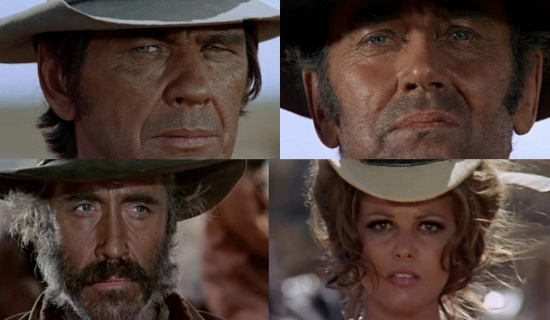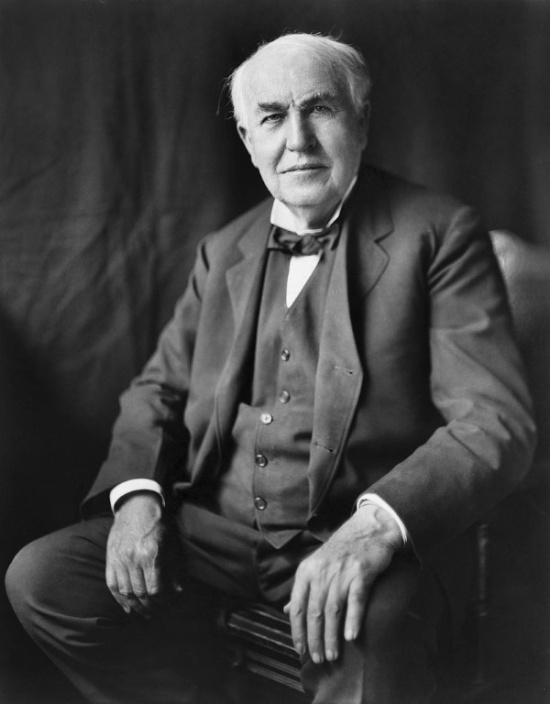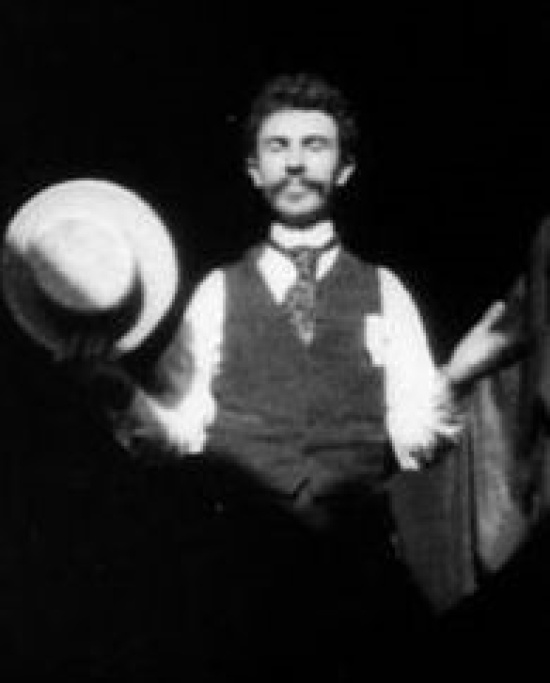Charles Bronson, Henry Fonda, Claudia Cardinale, Jason Robards — stills from Once Upon a Time in the West.
If you’re not doing anything this coming Tuesday evening, you could do worse than come down to the Humboldt County Library in Eureka at 6 pm and watch Once Upon a Time in the West, which I’m hosting. I’ve already raved about this 1968 movie, “the western to end all westerns,” in my LoCO piece for March 29, 2015, The Good, the Bad and the Awesome. OUTWEST (for short) regularly makes “best of” lists as both one of the greatest movies of all time, and one of the top three best westerns of all time. The Italian director Sergio Leone made it both as homage to American westerns and as a criticism of virtually all that had gone before. His Old West was dirty, muddy and messy; his protagonists were neither all good nor all bad; his towns were half-built and dusty; his shoot-outs were all about the lead-up to the action; and he typically told the story with close-ups of eyes rather than long speechifying.
So, in preparation for introducing the movie (I’ll keep it short, I promise—the movie is 2 hours 46 minutes in the form we’ll be showing on Tuesday), I watched part of the library’s Blu-ray version a few weeks ago…and was gobsmacked! I’d never seen the 2011 Blu-ray version previously—I’d seen the movie long, long ago in the early 1970s, and watched it repeatedly on DVD, but the Blue-ray (released four years ago) is something else: it’s incredibly sharp, colors are vibrant, every hair in Jason Robard’s scruffy beard can be counted. For me, this was a revelation, like I was seeing the flick for the first time.
What was so shocking is that OUTWEST was filmed in Techniscope, a format that by definition has half the resolution compared with standard 35-millimeter film, i.e. each frame holds half the information.
Still from Dickson Greeting, the first movie to be shown to an American audience, 1891. Dickson was Edison’s partner in developing 35mm film (public domain).
In the early days of flexible film, 35 millimeter (about 1 3/8 inches) was adopted as the de facto international standard width for movies. In the late 19th century, inventors were experimenting with dozens of widths, from 1/2 inch to as much as 3 inches. Thomas Edison and his partner William Dickson bought 1 1/2 inch wide flexible film stock from George Easton, slicing it down to 1 3/8 inches. This turned out to be an ideal compromise between quality and quantity: reasonably good images at a reasonable price.
By 1909, the 35mm format known and beloved by photographers in the pre-digital age was finalized, with four perforations on each side of each frame. For decades, virtually all movies were shot with this stock (and, starting in 1927, incorporating a sound strip) with a frame format of 1.375 to 1. Only in 1952, starting with Cinerama, was this ratio challenged by widescreen formats.
Back to Techniscope. Whereas previous widescreen formats had added information to each frame, the Techniscope process halved it by splitting the standard frame in two horizontally, for a wide aspect of 2.33 to 1. Instead of a “pulldown” of four perforations per frame, Techniscope uses two (hence its alternative name “2-perf”). Introduced by Technicolor Italia in 1960 as a way of shooting widescreen movies for less—twice the bang for the buck, as it were, “Techniscope was primarily an alternative format used by low-budget film makers, mainly in the horror and western genres.” (Wikipedia). It’s a production-only format, needing to be converted (twice, for technical reasons) for screening by regular 35 mm projectors in cinemas.
Techniscope half-frame format. (Max Smith, Wikimedia).
Wikipedia again: “During its primary reign of 1960-1980, more than 350 films were photographed in Techniscope…” Sergio Leone and his long-time director of cinematography, Tonino Delli Colli, used the process for the three Clint Eastwood spaghetti westerns (Fistful of Dollars, For a Few Dollars More and The Good, the Bad and the Ugly) and of course — the point of this column — for Once Upon a Time in the West.
Which is why I was blown away by the Blu-ray version (and hope you will be too). How was it possible to create such sharp images with half the image area? Turns out, MGM/Paramount was able to locate the original 2-perf negative for digital scanning, eking out every last iota of information. The result is stunning, as I say.
Maybe I shouldn’t have been that shocked. Turns out, Techniscope is having something of a revival. In the last three years, several Hollywood movies have been shot in Techniscope, including I’m Yours, Argo, and Silver Linings Playbook. What’s not to love if it’s good enough for Claudia Cardinale in 1968 and Jennifer Lawrence in 2012?
###
Barry Evans gave the best years of his life to civil engineering, and what thanks did he get? In his dotage, he travels, kayaks, meditates and writes for the Journal and the Humboldt Historian. He sucks at 8 Ball. Buy his Field Notes anthologies at any local bookstore. Please.




CLICK TO MANAGE